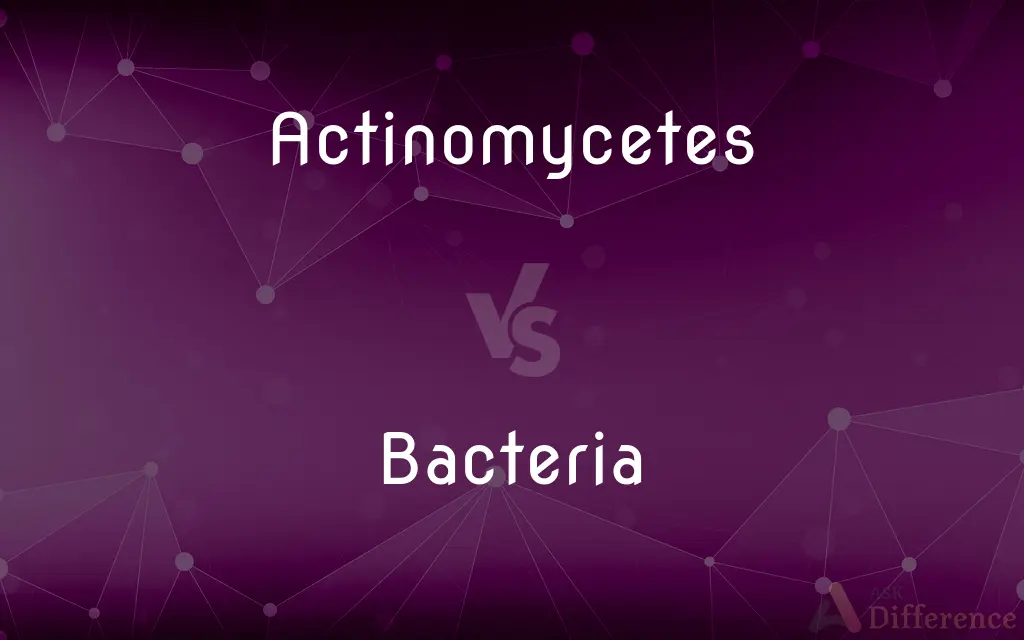Actinomycetes vs. Bacteria — What's the Difference?
Edited by Tayyaba Rehman — By Fiza Rafique — Updated on September 27, 2023
Actinomycetes are a group of gram-positive bacteria, known for their filamentous growth. Bacteria are single-celled microorganisms with various shapes and physiological traits.

Difference Between Actinomycetes and Bacteria
Table of Contents
ADVERTISEMENT
Key Differences
Actinomycetes and bacteria represent microorganisms vital for various ecological and clinical contexts. Actinomycetes, while being bacteria themselves, are distinct due to their tendency to grow in a filamentous manner, similar to fungi. On the other hand, bacteria as a broader term encompasses a vast variety of single-celled organisms, exhibiting diverse morphologies from cocci to bacilli.
In the medical world, both actinomycetes and bacteria hold significance. Actinomycetes are particularly known for producing over two-thirds of naturally derived antibiotics, a testament to their medical importance. Bacteria, depending on the species, can be beneficial, neutral, or pathogenic, playing roles in processes like digestion or causing diseases respectively.
Soil health is intricately linked with the presence of actinomycetes and bacteria. Actinomycetes participate in the decomposition of organic matter, contributing to soil fertility. Bacteria, being omnipresent, engage in nitrogen fixation, decomposition, and nutrient cycling, underlining their ecological importance.
Though actinomycetes are a subset of bacteria, their distinguishing characteristics, especially their filamentous growth and spore formation, set them apart. Bacteria, with their vast diversity, can be found in nearly every environment on Earth, from the deep sea to human guts, showcasing their adaptability and range.
Comparison Chart
Morphology
Typically filamentous, resembling fungi.
Varies (cocci, bacilli, spirals, etc.).
ADVERTISEMENT
Antibiotic Production
Known to produce a majority of naturally derived antibiotics.
Some produce antibiotics, but not as predominantly.
Ecological Role
Decomposition of organic matter in soil.
Diverse roles including decomposition, nitrogen fixation, etc.
Medical Significance
Important for antibiotic production; some can cause diseases like actinomycosis.
Range from beneficial to pathogenic.
Growth Form
Grow as hyphae and can form spores.
Grow mainly as individual cells, some can form chains or clusters.
Compare with Definitions
Actinomycetes
Filamentous, gram-positive bacteria.
Actinomycetes play a crucial role in producing various antibiotics.
Bacteria
Single-celled microorganisms without a defined nucleus.
Bacteria can be found in various environments, from hot springs to the human gut.
Actinomycetes
Bacteria known for their branching hyphae.
The presence of actinomycetes gives the soil its characteristic earthy smell.
Bacteria
Microbes that can be beneficial, neutral, or pathogenic.
Probiotic supplements contain beneficial bacteria to aid digestion.
Actinomycetes
Producers of secondary metabolites with medical significance.
Many drugs in use today owe their origin to compounds derived from actinomycetes.
Bacteria
Organisms with a simple cellular structure, often protected by a cell wall.
Bacteria reproduce rapidly, sometimes doubling their population in just minutes.
Actinomycetes
Bacteria resembling fungi due to their growth patterns.
Upon observation, one might mistake actinomycetes for fungi because of their similar appearance.
Bacteria
Agents of many infections and diseases in humans and animals.
Antibiotics are used to treat various bacterial infections.
Actinomycetes
Microorganisms responsible for decomposing complex organic compounds.
Actinomycetes break down tough plant material, enriching the soil.
Bacteria
Key players in ecological processes like decomposition and nitrogen fixation.
The nitrogen cycle would be incomplete without the crucial role of certain bacteria.
Actinomycetes
Any of various spore-forming, chiefly filamentous bacteria of the order Actinomycetales that are abundant in soil. Some species produce natural antibiotics, and some are human pathogens.
Bacteria
Bacteria ( (listen); common noun bacteria, singular bacterium) are a type of biological cell. They constitute a large domain of prokaryotic microorganisms.
Actinomycetes
Plural of actinomycete
Bacteria
Plural of bacterium.
Actinomycetes
Branched gram-positive bacteria, often found in soil, some of which are pathogenic for humans and animals.
Bacteria
(US) A type, species, or strain of bacterium.
Bacteria
Alternative form of bacterium.
Bacteria
Lowlife, slob (could be treated as plural or singular).
Bacteria
An oval bacterium, as distinguished from a spherical coccus or rod-shaped bacillus.
Bacteria
See Bacterium.
Bacteria
(microbiology) single-celled or noncellular spherical or spiral or rod-shaped organisms lacking chlorophyll that reproduce by fission; important as pathogens and for biochemical properties; taxonomy is difficult; often considered plants
Common Curiosities
What's the role of bacteria in our gut?
Gut bacteria aid in digestion, nutrient absorption, and immune system function.
Can actinomycetes and bacteria be seen without a microscope?
Typically, no. They are microscopic and require magnification to be observed.
Why are actinomycetes important in medicine?
Actinomycetes produce many naturally derived antibiotics.
Do actinomycetes contribute to soil health?
Yes, they play a role in decomposing organic matter, enriching the soil.
How do actinomycetes look under the microscope?
They appear filamentous and branching, similar to fungal hyphae.
Are all bacteria harmful to humans?
No, many bacteria are beneficial or neutral; only a subset causes diseases.
How do bacteria reproduce?
Most bacteria reproduce asexually by binary fission.
Do all bacteria cause food spoilage?
No, while some bacteria spoil food, others are used to make foods like yogurt.
Are actinomycetes fungi?
No, actinomycetes are bacteria but have a filamentous growth similar to fungi.
Can bacteria live in extreme conditions?
Yes, some bacteria, called extremophiles, thrive in extreme environments.
Can bacteria generate energy without oxygen?
Yes, some bacteria undergo anaerobic respiration or fermentation in oxygen's absence.
Do bacteria have DNA?
Yes, bacteria have a single, circular DNA molecule in their cytoplasm.
Are actinomycetes found in human infections?
Yes, some actinomycetes species can cause diseases like actinomycosis.
Are actinomycetes found in water?
While primarily soil-dwellers, some actinomycetes species can be found in freshwater habitats.
Are actinomycetes and bacteria the same?
Actinomycetes are a subset of bacteria with specific characteristics, but not all bacteria are actinomycetes.
Share Your Discovery

Previous Comparison
Inflow vs. Influx
Next Comparison
Joshua vs. JoshAuthor Spotlight
Written by
Fiza RafiqueFiza Rafique is a skilled content writer at AskDifference.com, where she meticulously refines and enhances written pieces. Drawing from her vast editorial expertise, Fiza ensures clarity, accuracy, and precision in every article. Passionate about language, she continually seeks to elevate the quality of content for readers worldwide.
Edited by
Tayyaba RehmanTayyaba Rehman is a distinguished writer, currently serving as a primary contributor to askdifference.com. As a researcher in semantics and etymology, Tayyaba's passion for the complexity of languages and their distinctions has found a perfect home on the platform. Tayyaba delves into the intricacies of language, distinguishing between commonly confused words and phrases, thereby providing clarity for readers worldwide.














































